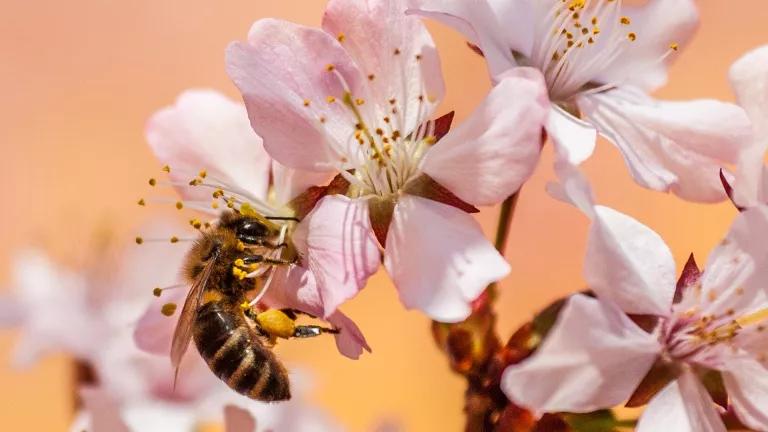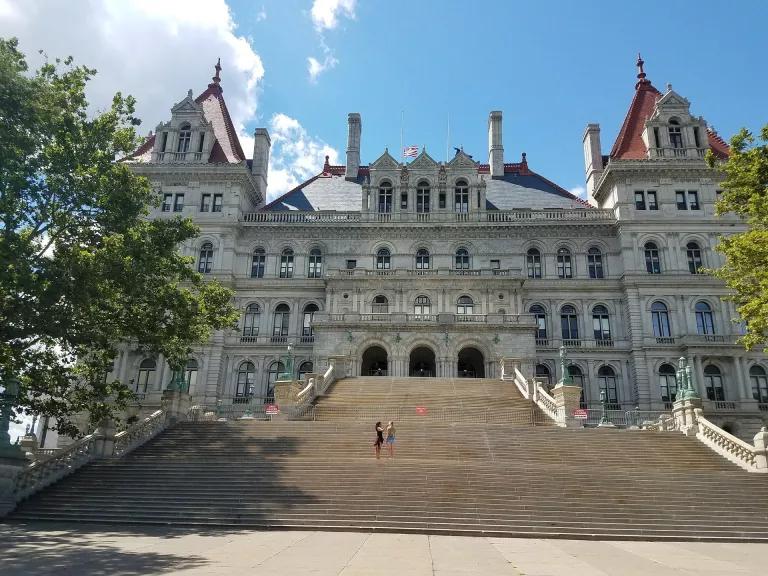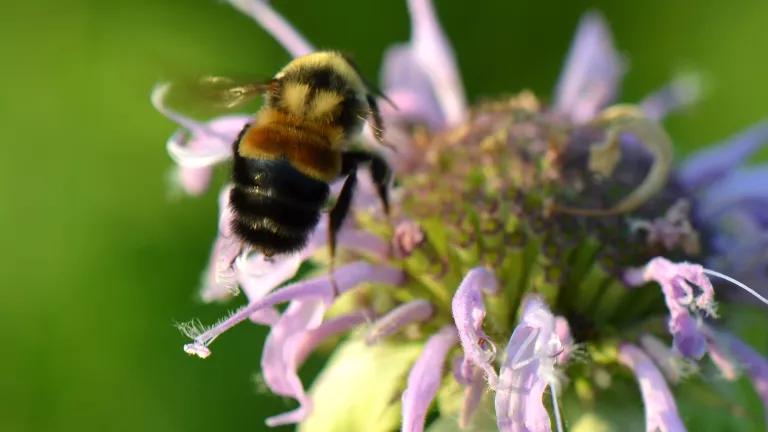Take Action to Protect Bees During National Pollinator Week
This Pollinator week, let’s heed the science and skip the fluff. Here’s how you can take action now to protect pollinators and human health.

A cute bee picture—typical of National Pollinator Week.
National Pollinator Week may officially be here, but its arrival comes at an unprecedented time. In the midst of a pandemic, a presidential election, and perhaps the largest social justice movement since the 1960s, a week dedicated to these little critters might not rise to the top of everyone’s feeds. But the problems that affect bees affect us all, and this week—though symbolic in nature—is a great opportunity to demand action from our lawmakers.
Pollinator Week: Spurred by Catastrophic Honey Bee Losses
First created by a U.S. Senate resolution in 2006—the year that beekeepers saw sudden, massive, and then-unexplained losses of honey bee colonies nationwide—the week is often a time for light stories on pollinator-friendly gardening tips and social media posts of cute bees and butterflies. To the cynic, it may feel like a big exercise in “bee-washing”—where corporations and politicians pay lip service to protecting pollinators, but effectively do nothing to fix the very real and longstanding crisis of continued massive pollinator losses (part of the larger insect losses sometimes called an insect apocalypse).
These losses matter. Pollinators are responsible for one out of every three bites of food we eat and vital to the production of 75 percent of the world’s top food crops—everything from apples to zucchini. They are also critical to the reproduction of nearly 90 percent of flowering plants (i.e., most plants on the face of the Earth). Further losses of pollinators not only jeopardize our food security, but also the survival of our ecosystems.
What’s Triggering the Pollinator Apocalypse?
While there isn’t a single factor fully responsible for the pollinator crisis, there is one big, preventable one—the rampant use of neonicotinoid or “neonic” pesticides. Neonics have made U.S. agriculture 48 times more harmful to insects since their introduction, and contaminate food, soil, plants, and water across the country on an almost unprecedented scale. In New York and New Jersey, for example, neonics frequently appear in surface waters, and contaminate nearly a third of Long Island groundwater samples—a major source of drinking water for Long Islanders. Worse yet, studies are finding that what’s bad for bees is bad for everyone else, with widespread neonic pollution now linked to losses or harms to birds, fish, deer, bats, and humans too (for more detailed info see our Bigger Than Bees Report).
Potential Risks to Humans from Neonic Exposure
According to the Centers for Disease Control and Prevention, half the U.S. population is regularly exposed to neonics (as demonstrated by the chemicals showing up in our urine), which is a big concern given research indicating neonics may increase risk of developmental or neurological damage, including malformations of the developing heart and brain, memory loss, and tremors. Health scientists from around the country have already raised alarms (see here and here) about the growing concerns to EPA, but the Trump administration appears determined to ignore them.

The New York State Capitol in Albany, New York—a great place to plant seeds of change for pollinators.
Demand Action Now
This Pollinator week, let’s heed the science and skip the fluff. Here’s how you can take action now to protect pollinators and human health.
- If you live in New York or New Jersey, contact your state leaders – New York and New Jersey are poised to lead the country on critically needed neonic protections with The Birds and Bees Protection Act in the Empire State and A2070/S1016 in the Garden State. Your voice really (really!) matters, so let your representatives know. While a call is always best, you can also take action by email here if you live in New York and here if you live in New Jersey.
- If you live elsewhere, also call your representatives – Mid-Atlantic states don’t have a monopoly on pollinator action. From coast to coast, state legislatures and agencies have considered addressing pollinator declines, but few have taken meaningful action. Let your state elected officials know you want them to target the causes of pollinator declines at the roots; flowery resolutions are poetic, but don’t help much. We need laws that restrict bee-killing pesticides like neonics and create more high-quality pollinator habitat.
- And don’t forget about your federal leaders – Although Washington may seem broken right now, your federal representatives shouldn’t be let off the hook. Let your legislators know you support legislation like the Saving America’s Pollinators Act and Protect Our Refuges Act, and let EPA know that it must act too (just like its sister agencies have in the EU and Canada) to rein in rampant neonic use.
- Plant native flowers and don’t use pesticides – Ok, ok, it wouldn’t be a true Pollinator Week blog without a little gardening advice. If you want to help bees, butterflies, and other pollinators in your own backyard, plant native flowers and milkweed (your local native plant society can often help identify good choices), and take a pass on pesticides. And watch out!—many nursery plants and home garden products may already have neonics in them, so purchase wisely and beware of all-in-one products, like this neonic-laden fertilizer.





